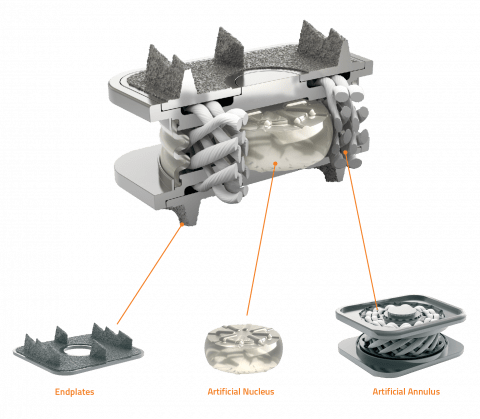What is spinal fusion?
Lower back pain and neck pain are some of the most common reasons people seek medical treatment. Common treatments may include anti-inflammatory medicines, heat or ice, and physical therapy. While most pain will get better on its own within three months, oftentimes pain will persist and become chronic. When treatments no longer offer relief and pain does not appear to be getting better, surgery may be an option.
Spinal fusion surgery is a procedure where spinal bones are fused together with a bone graft. When healing is complete, two or more vertebral bones will be fused together like a single bone. After fusion surgery, the vertebral bones of the spine no longer move independently, causing less flexibility and mobility.
Spinal fusion is permanent and not reversible. When you have a fusion, there will be implants in your back such as rods, screws, bone graft or disc implant/spacers. There will be a complete loss of motion of the segments which are fused. The only options to revise this if you are not happy include extending the fusion or to try a spinal cord stimulator. Revisions do not have a very good success record.
So how do you know if spinal fusion is for you? There are four conditions where there is little debate about the need for a spinal fusion. These include:
- A spine deformity that needs to be corrected
- Trauma that causes a fracture of dislocation of the spine will probably need a fusion
- A tumor or other destructive process
- Excessive instability after a previous surgery
The underlying philosophy of a fusion is if there is no motion, there will be no pain. The purpose of the fusion is to eliminate all motion at a particular disc level.
To determine if a spinal fusion is right for you, it is important to discuss all of your options with a physician. To schedule a consultation with a physician near you, please visit the following link. Locate a surgeon near you today
Drawbacks of spinal fusion surgery
Fusion surgery may lead to stiffness and a loss in the range of motion. Areas above and below the fusion are subject to increased stress meaning a patient may be more likely to develop problems in the adjacent discs over time. Problems may be short term or long term.
Short term problems may include:
- Spinal fluid leak
- Excessive bleeding
- Misplaced hardware
- Nerve damage
- Infection
- Blood clots in the legs
- Long term opioid use
Long term problems may include:
- Adjacent disc disease, which is when remaining parts of the spine that were not fused begin to show premature wear and tear as they do extra work to compensate for the fused area.
Recovery time after a spinal fusion can vary with each patient. Most will return home from the hospital within two to four days and be able to drive in a couple of weeks, once opioid medications have stopped. It typically takes four to six weeks to return to a sedentary job but it can take three or more months to return to more physical activities.
Are there alternatives to spinal fusion?
There are a number of alternative treatments available for back pain besides having a major surgery like spinal fusion. There are non-surgical alternatives, as well as surgical. To determine which alternative would be best for you, it is important to discuss all options with your physician and decide together on a personalized treatment plan. Below you will find an overview of both non-surgical and surgical options for you to discuss with a physician before making a decision.
Non-surgical alternatives to spinal fusion
- Physical activity and targeted exercises – Exercise increases blood flow and the flow of oxygen and nutrients to the spine. This stimulates the healing process and helps alleviate stiffness. Targeted exercise can strengthen the muscles that support the spine which can reduce the impact on your spine during daily activities.
- Physical therapy – PT improves strength, mobility and stamina. Physical therapists can target problem areas and help correct abnormalities in your gait, posture and lifting techniques to reduce spinal pressure.
- Spine manipulation – This is a technique by chiropractors to restore spinal alignment. When combined with the other options listed here, patients may be able to avoid spinal fusion surgery.
- A healthy diet and weight loss – Being overweight increases the strain on your joints, including your spine. Extra pounds add to the impact exerted on your spine.
- Epidural steroid injections – These can help calm pain caused by an irritated or compressed spinal nerve. The injections contain powerful anti-inflammatory medication that can offer relief within a few days. Injections should not be used as a long term solution as more than three to four a year can lead to tissue damage.
Surgical alternatives to spinal fusion
- Disc replacement surgery – Disc replacement surgery involves replacing the painful disc in the spine with an artificial disc. The goal of artificial disc replacement surgery is to preserve the normal motion of the spine, unlike fusion, which eliminates motion at the painful spinal segment.
- Posterior dynamic stabilization – Different from fusion in that posterior dynamic stabilization seeks to preserve motion in the spine while also taking pressure off the diseased vertebral
- disc. The theory is that removing pressure from the painful disc will create a favorable healing environment and reduce pain.
- Disc regeneration – Researchers in cellular and molecular biology are exploring ways to use gene therapy to stimulate regeneration of the vertebral disc and/or to slow or prevent degeneration of the disc.
- Microdiscectomy – A minimally invasive procedure in which part of the intervertebral disc is removed. By removing a section of the disc, pressure on the nerve may be drastically reduced or eliminated.
- Laminectomy – The spine is supported by a stack of bones called vertebrae and each vertebra has two arch shaped areas called laminae. Sometimes, removing the laminae can help decompress the spinal canal or reduce pressure on nearby nerves.
- Percutaneous endoscopic discectomy – A minimally invasive procedure that can help to relieve pressure within the disc and reduce or even eliminate pain. A small incision is made and a camera and other tools are inserted through a tube into the spine, relieving pressure on the damaged disc.
Artificial disc replacement
Orthofix Offers a Natural Choice for M6 Disc Replacement
The M6-C™ artificial cervical disc is an innovative option for those looking for an alternative to spinal fusion. The artificial disc is designed to mimic your natural disc, allowing you to move up and down, backwards and forwards, side to side, as well as rotating left and right. The M6-C artificial cervical disc allows your spine to move naturally to potentially minimize the stress to the discs above and below.
M6-C Artificial Cervical Disc Components

- Titanium endplates anchor the disc to the bones of neighboring vertebrae which will provide long term stability.
- Artificial nucleus is composed of viscoelastic polymer.
- Artificial annulus is composed of polyethylene fiber material.
- The annulus and nucleus work together to replicate the range of movement and cushioning effect of the natural disc.
For more information, please download the patient brochure we have provided below.
M6-C Artificial Cervical Disc Brochure
As one of the leading medical device companies in the world focusing on spine and orthopedics, Orthofix is committed to helping people enjoy a pain free lifestyle.
https://www.orthofix.com/ifus/motion-preservation-m6c/
Making the right choice
Being diagnosed with a spine condition can be an overwhelming, frightening experience. Choosing the appropriate treatment can be a difficult decision and should involve a patient’s physician.
To see if you would be a good candidate for disc replacement surgery, please visit the following link to take the quiz and learn more. Am I a candidate for disc replacement?
For additional information and to find a disc replacement surgeon near you, please visit the following link. Find a disc replacement surgeon near you
